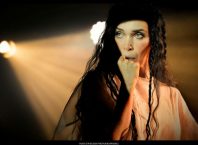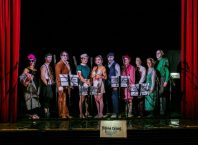The last trace of transmission oil and axel grease has long since disappeared, but their memory remains in the building. Walls painted black, spotlights, cables and wires invite other ghosts to join them, creating a palimpsest of images in this converted garage that has become synonymous with alternative theater. Tmuna Theater is the last place one would expect to find Shakespeare. Yet the bard has taken up residence on the back streets of Tel Aviv.
Richard III, directed by Oded Littman and starring Zvi Sahar returns to the stage on April 12th and 13th after a brief hiatus in its year long run. Nava Zuckerman, founder and artistic director of Tmuna, had noticed the pair’s intriguing version of the play several years ago in Nisui Kelim, a program created to nurture interdisciplinary, experimental theater under the artistic direction of Amitai Yaish. Zuckerman suggested that they develop their initial project into a full length play, and after two years of intensive work, the task was accomplished.
All the performance spaces in Tmuna are very exposed. Audience and performers occupy the same black box. There is no stage curtain: everything is visible. The play is performed in a smaller, inner room in Tmuna, called “the cycle”, where it creates its own unique environment. Two ornate black columns define a timeless, nameless space where men wear business suits with white ruffled collars and a video camera invites the audience to an intimate conversation with a murderer.
Actor Zvi Sahar’s passion for the play (he initially attempted his own translation, some of his inventive word play enhances the current production) led him to experiment with the text, delivering Richard’s monologues to a video camera. Throughout the play, Richard speaks in two voices, his public voice and his private monologues. Speaking into the camera (initially with his back to the audience) creates the illusion of privacy, while the image of Richard’s face on the large screen is inescapable, overwhelming, projecting Richard’s extreme self-involvement.
Shakespeare’s Richard (for another Richard, read Josephine Tey’s Daughter of Time) presents a difficult challenge to any production in translation, as it focuses on an evil, physically deformed character whose single appealing quality, and means of success, is through his brilliant manipulation of language. It is hard to believe that this can be accomplished without Shakespeare’s English, yet Littman and Sahar have succeeded in creating a credible, charismatic villain. Commenting on the difficulties of working with such a densely worded text in light of fact that Israeli actors often lack the necessary training in diction, Littman responds that the audience will always be able to understand the dialogue if the actors understand it, grounding the play’s success in “the emotional understanding of the actor.” In his portrayal of Richard, Sahar finds something vulnerable within the character, a raw desire that renders him more human, despite his monstrous acts.
One radical departure from Shakespearean tradition is the elimination of any visual representation of Richard’s physical disabilities, the initial source of his villainy: “I, that am not shaped for sportive tricks…am determined to prove a villain”. “What matters is the way that the handicap affects him,” explains Sahar. Littman adds, completing Sahar’s sentence, “being handicapped is his identity…his inner feeling. He has internalized disability.”
The ensuing years of close work have not diminished the intensity of the dialogue between Littman and Sahar. A month before the play was scheduled to open; they still had not resolved the use of the video camera to their satisfaction. Littman recalls, “We devoted so much energy to figuring it out that we fought, we almost stopped working together.” Instead they decided to abandon their idea of using the camera. After a week they decided that like the character of Richard, they “had no choice but to succeed” and the two worked alone on the monologues, without an actual video camera, Sahar talking into a shoe. This attention to detail and character reverberates throughout the play. The cast gives a strong and affective performance as they are by turns attracted and repelled, played upon by the conniving Richard.
The white screen provides an additional visual element. Transitional scenes are presented as a shadow play reminiscent of Thai shadow puppets. Opening with the shadow of a couple dancing, the motif of dance continues throughout the play, emerging in those places where violence erupts: the two murderers of the Duke of Clarence, Richard’s brother, engage in a comic tango before doing the deed, and the final battle scene is a choreographed dance with daggers. The dance emphasizes the distance between public and private, the elaborate formality that conceals the violent passions. The physical presence of the actors on the stage, their elaborate dance of intimacy and distance, make one acutely aware that the face itself is a mask, a screen.
Any lover of Shakespeare cannot help but feel a sense of loss in translation. Is this Shakespeare? Yet the plays were created for the stage – the First Folio was not published until seven years after Shakespeare’s death. In every reading, in every production we create our own Shakespeare. In this intimate encounter, the audience is just a few steps away from the stage, the actors performing have just finished building the set, and when the applause subsides, they will take it apart, carrying out the props to be stored until the next performance. Audience and performers brought together by the will to create, to take risks, to experience transformation. Walking out into the sweat and heat of a Tel Aviv night, to “have more talk of these sad things”, memory draws graffiti on the mind – Shakespeare was here.
A 3 minute video clip from the play:
Richard III, Tmuna 2007-2008, Trailer from oded littman on Vimeo.






Comments are closed.